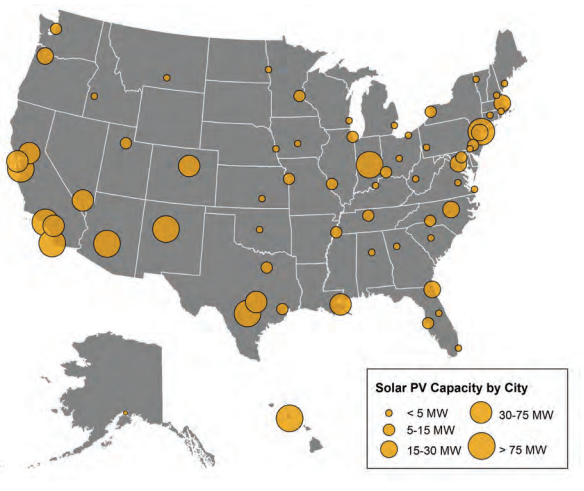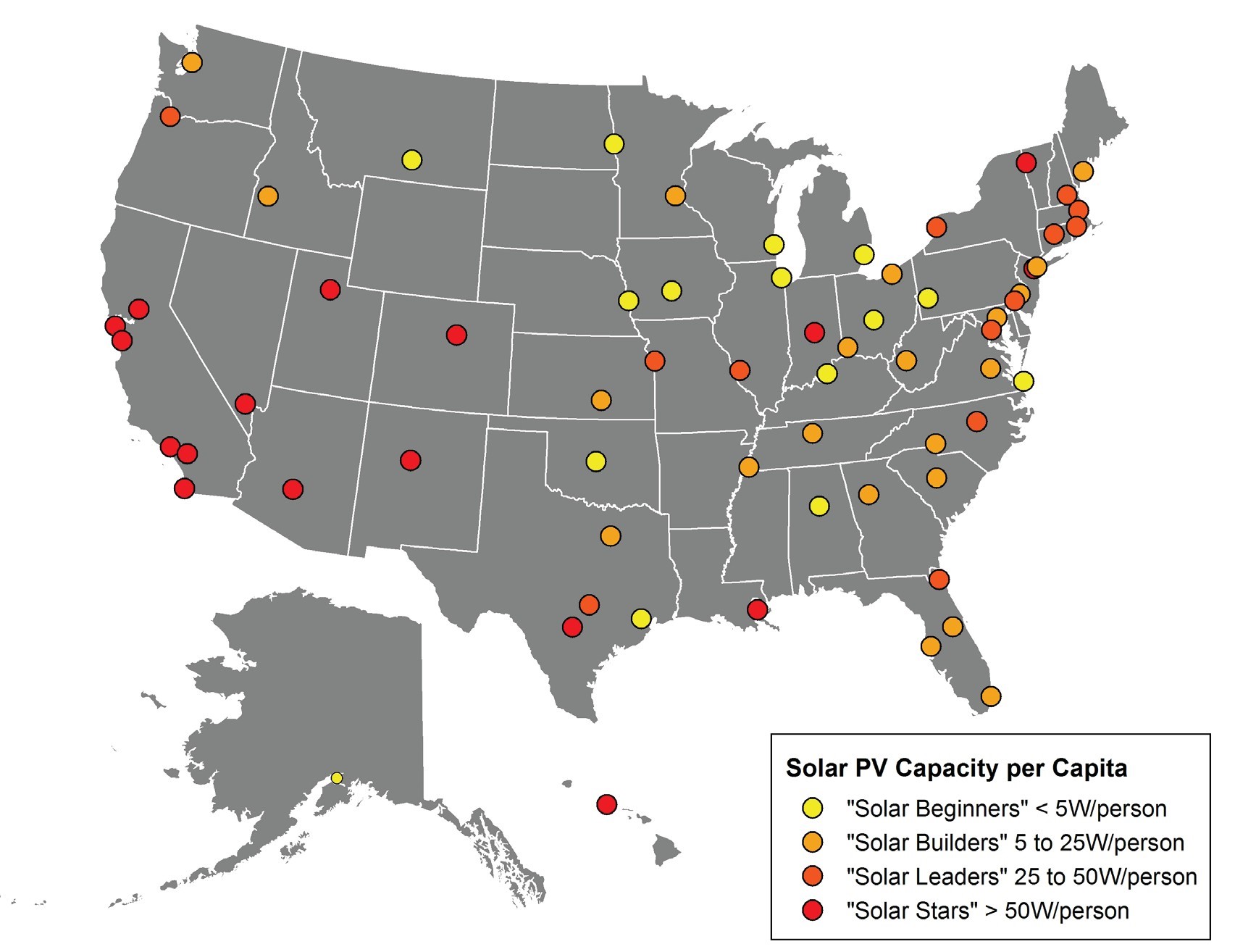Abi Bradford
Policy Analyst
Solar energy is booming in America and cities are leading the way. This development is happening the fastest, not necessarily in cities with the most sunlight, but in those with the strongest local and state policies to support this growth. Shining Cities 2017 is the fourth edition in our series ranking America’s largest cities by total and per capita installed solar PV capacity.
Policy Analyst
Former Policy Analyst, Frontier Group
Newer editions of this report are available:
Solar power grew at a record-breaking pace in 2016. The United States now has 42 gigawatts (GW) of solar photovoltaic (PV) energy capacity, enough to power 8.3 million homes and reduce carbon dioxide emissions by 52.3 million metric tons annually. Hundreds of thousands of Americans, especially in our cities, have invested in their own solar panels or solar projects in their communities and millions more are ready to join them.
America’s major cities have played a key role in the clean energy revolution and stand to reap tremendous benefits from solar energy. As population centers, they are major sources of electricity demand and, with millions of rooftops suitable for solar panels, they have the potential to be major sources of clean energy as well.
Figure ES-1: U.S. Cities by Cumulative Installed Solar PV Capacity, End of 2016

Table ES-1: Top 20 Solar Cities by Total Installed Solar PV Capacity, End of 2016*
|
City |
State |
Total Solar PV Installed (MW-DC) |
Total Solar PV Rank |
Per Capita Solar PV Installed (Watts-DC) |
Per Capita Rank |
Rooftop Solar PV Potential for Small Buildings (MW) † |
|
San Diego |
CA |
303 |
1 |
217.6 |
2 |
2,219 |
|
Los Angeles |
CA |
267 |
2 |
67.1 |
15 |
5,444 |
|
Honolulu |
HI |
175 |
3 |
495.2 |
1 |
N/A |
|
San Jose |
CA |
174 |
4 |
169.1 |
3 |
1,639 |
|
Phoenix |
AZ |
165 |
5 |
105.6 |
7 |
2,981 |
|
Indianapolis |
IN |
127 |
6 |
148.5 |
4 |
N/A |
|
New York |
NY |
117 |
7 |
13.7 |
38 |
1,277 |
|
San Antonio |
TX |
117 |
8 |
79.5 |
12 |
3,721 |
|
Albuquerque |
NM |
82 |
9 |
146.1 |
5 |
1,252 |
|
Las Vegas |
NV |
75 |
10 |
119.6 |
6 |
946 |
|
San Francisco |
CA |
46 |
11 |
53.5 |
17 |
672 |
|
Denver |
CO |
45 |
12 |
66.4 |
16 |
677 |
|
Sacramento |
CA |
40 |
13 |
81.4 |
10 |
777 |
|
New Orleans |
LA |
37 |
14 |
95.0 |
9 |
1,277 |
|
Riverside |
CA |
32 |
15 |
98.9 |
8 |
612 |
|
Austin‡ |
TX |
31 |
16 |
33.0 |
24 |
1,443 |
|
Portland |
OR |
27 |
17 |
43.0 |
19 |
1,397 |
|
Washington, D.C. |
DC |
25 |
18 |
37.5 |
21 |
344 |
|
Jacksonville |
FL |
25 |
19 |
29.0 |
27 |
1,715 |
|
Newark |
NJ |
22 |
20 |
78.1 |
13 |
154 |
* This includes all solar PV capacity (rooftop and utility-scale solar installations) within the city limits of each city. It does not include solar power installed in the extraterritorial jurisdictions of cities, even those installed by or under contract to municipal utilities. See methodology for an explanation of how these rankings were calculated. See Appendix B for city-specific sources of data.
† This reflects the maximum technical solar PV capacity that could be installed on appropriate small building rooftops in each city. These figures were calculated by the U.S. Department of Energy. Data were unavailable for cities with “N/A” listed
‡ Due to an improvement in methodology or data source for this city, total and per capita solar PV capacities reported in this table are not directly comparable with estimates for this city in previous versions of this report. See Appendix B for details on specific cities
As of the end of 2016, 20 cities—representing just 0.1 percent of U.S. land area—accounted for 5 percent of U.S. solar PV capacity. These 20 cities have nearly 2 GW of solar PV capacity—nearly as much solar power as the entire country had installed at the end of 2010.
San Diego leads the nation in total installed solar PV capacity among the 66 cities surveyed in this report, replacing Los Angeles, which had been the national leader for the past three years. Honolulu rose from sixth place for total PV capacity at the end of 2015 to third place at the end of 2016. (See Table ES-1.)
Even the cities that have seen the greatest solar success still have vast amounts of untapped solar energy potential. For instance, San Diego has developed less than 14 percent of its technical potential for solar energy on small buildings. To take advantage of that potential, and move America toward an economy powered by 100 percent renewable energy, city, state and federal governments should adopt a series of pro-solar policies.
The cities with the most solar PV installed per capita are the “Solar Stars”—cities with 50 or more watts of installed solar PV capacity per person. These cities have experienced dramatic growth in solar energy and are setting the pace nationally for solar energy development. Honolulu, San Diego, San Jose, Indianapolis and Albuquerque are the top five cities in the nation for installed solar PV capacity per person. (See Figure ES-2 and Table ES-2.) Notable changes in 2016 include:
Regional leaders for per capita solar capacity include Honolulu in the Pacific region, Albuquerque in the Mountain region, Indianapolis in the North Central region, New Orleans in the South Central region, Wilmington, Delaware, in the South Atlantic region and Burlington, Vermont, in the Northeast region.
Figure ES-2: U.S. Cities by Installed Solar PV Capacity per Capita, End of 2016 (Watts Per Person)

Table ES-2: The “Solar Stars” (Cities with 50 or More Watts of Solar PV per Person, End of 2016)
|
City |
State |
Total Solar PV Installed (MW-DC) |
Total Solar PV Rank |
Per Capita Solar PV Installed (Watts-DC) |
Per Capita Rank |
Change in Per Capita Rank 2015-2016 |
|
Honolulu |
HI |
175 |
3 |
495.2 |
1 |
0 |
|
San Diego |
CA |
303 |
1 |
217.6 |
2 |
+2 |
|
San Jose |
CA |
174 |
4 |
169.1 |
3 |
0 |
|
Indianapolis |
IN |
127 |
6 |
148.5 |
4 |
-2 |
|
Albuquerque |
NM |
82 |
9 |
146.1 |
5 |
0 |
|
Las Vegas |
NV |
75 |
10 |
119.6 |
6 |
+1 |
|
Phoenix |
AZ |
165 |
5 |
105.6 |
7 |
-1 |
|
Riverside |
CA |
32 |
15 |
98.9 |
8 |
+1 |
|
New Orleans |
LA |
37 |
14 |
95.0 |
9 |
-1 |
|
Sacramento |
CA |
40 |
13 |
81.4 |
10 |
+2 |
|
Burlington |
VT |
3 |
45 |
81.0 |
11 |
+2 |
|
San Antonio |
TX |
117 |
8 |
79.5 |
12 |
-2 |
|
Newark |
NJ |
22 |
20 |
78.1 |
13 |
-2 |
|
Salt Lake City |
UT |
15 |
23 |
77.5 |
14 |
0 |
|
Los Angeles |
CA |
267 |
2 |
67.1 |
15 |
0 |
|
Denver |
CO |
45 |
12 |
66.4 |
16 |
N/A |
|
San Francisco |
CA |
46 |
11 |
53.5 |
17 |
-1 |
America’s leading solar cities are those that have adopted strong pro-solar public policies or that are located within states that have done so. Among the most important steps cities have taken to advance solar energy are:
Cities with strong policies to compensate consumers for the solar energy they supply to the grid— such as net metering—are often leaders in solar development. Like rollover minutes on a cell phone bill, net metering gives renewable energy customers fair credit on their utility bills for the excess clean power they deliver to the grid. This simple billing arrangement is one of the most important policies for clearing the way for customer investment in solar.
Because net metering is such a powerful incentive for customers to switch to solar energy, fossil fuel interests and utilities have been attacking these policies across the country. In 2016 alone, 28 states proposed or passed changes to their net metering rules. For cities in these states, the changes have the potential to threaten their standing as solar energy leaders. For example, the controversial December 2015 decision by the Nevada Public Utility Commission to weaken net metering may threaten Las Vegas’ position as a top solar energy leader in the future.
U.S. cities have only begun to tap their solar energy potential. Cities such as Los Angeles, New York, Chicago and San Antonio have the technical potential to generate tens to hundreds of times more solar energy than they currently do, according to a National Renew- able Energy Laboratory (NREL) analysis of technical rooftop solar potential on small buildings. In fact, the majority of the cities in this report have developed less than 2 percent of their technical solar PV potential and the city that has tapped the greatest share of its potential, Newark, developed less than 15 percent of it. By maintaining strong pro-solar public policies, these and other cities can continue to lead America toward a future of 100 percent clean, renewable energy.
Strong public policies at every level of government can help the United States continue to harness clean solar energy. To achieve the nation’s full solar potential:
Policy Analyst
Former Policy Analyst, Frontier Group
